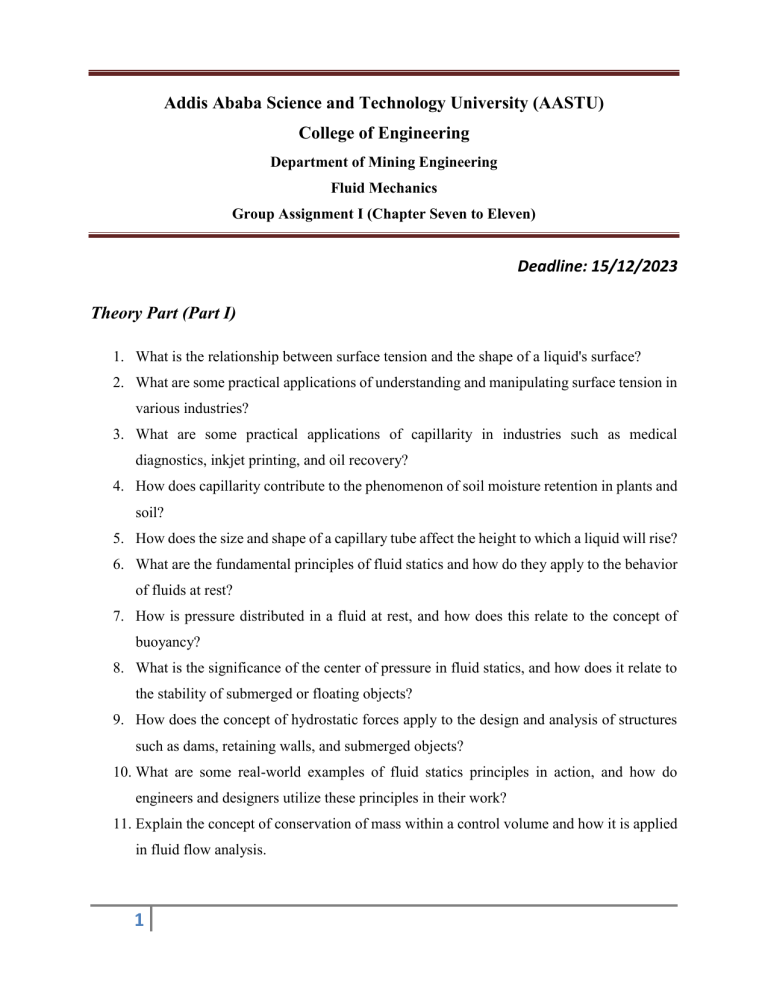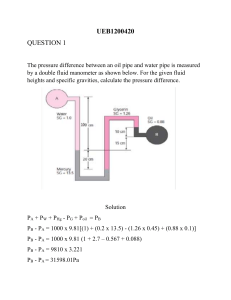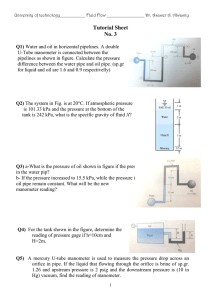
Addis Ababa Science and Technology University (AASTU) College of Engineering Department of Mining Engineering Fluid Mechanics Group Assignment I (Chapter Seven to Eleven) Deadline: 15/12/2023 Theory Part (Part I) 1. What is the relationship between surface tension and the shape of a liquid's surface? 2. What are some practical applications of understanding and manipulating surface tension in various industries? 3. What are some practical applications of capillarity in industries such as medical diagnostics, inkjet printing, and oil recovery? 4. How does capillarity contribute to the phenomenon of soil moisture retention in plants and soil? 5. How does the size and shape of a capillary tube affect the height to which a liquid will rise? 6. What are the fundamental principles of fluid statics and how do they apply to the behavior of fluids at rest? 7. How is pressure distributed in a fluid at rest, and how does this relate to the concept of buoyancy? 8. What is the significance of the center of pressure in fluid statics, and how does it relate to the stability of submerged or floating objects? 9. How does the concept of hydrostatic forces apply to the design and analysis of structures such as dams, retaining walls, and submerged objects? 10. What are some real-world examples of fluid statics principles in action, and how do engineers and designers utilize these principles in their work? 11. Explain the concept of conservation of mass within a control volume and how it is applied in fluid flow analysis. 1 12. How is momentum conservation applied within a control volume in fluid flow analysis, and what are its implications for understanding fluid behavior? 13. Discuss the concept of energy conservation within a control volume and how it is utilized in analyzing fluid flow and energy transfer. 14. Someone claims that the shear stress at the center of a circular pipe during fully developed laminar flow is zero. Do you agree with this claim? Explain. 15. Consider laminar flow of air in a circular pipe with perfectly smooth surfaces. Do you think the friction factor for this flow will be zero? Explain. 16. What is minor loss in pipe flow? How is the minor loss coefficient KL defined? 17. During a retrofitting project of a fluid flow system to reduce the pumping power, it is proposed to install vanes into the miter elbows or to replace the sharp turns in 90° miter elbows by smooth curved bends. Which approach will result in a greater reduction in pumping power requirements? Calculation Part (Part II) 1) A rectangular pontoon of mass 90 metric tons floats in sea water. It is 12m long, 7.5m wide and 3m deep. Find the metacentric height. Sea water has a density of 1025kg/m³ and the center of gravity of the pontoon may be taken at its geometrical center. 2) The velocity distribution for the flow of a newtonian fluid between two parallel plates as shown below is given by the equation u = 3V 2 y 2 [1 − (h) ], where V is the mean velocity. The fluid has a viscosity of 2 Pa/s. When V = 0.6 m/s and h=0.005 m, determine: a. The shearing stress acting on the bottom wall, and b. The shearing stress acting on a plane parallel to the walls and passing through the centerline (midpoint). 2 3) A long vertical wall separates seawater from fresh water. If the seawater has a depth of 7 ft, what depth of fresh water is required so that the net force on the wall is zero? What is the moment at the bottom of the wall, per unit length of wall (if any), when the net force is zero? 4) A force, P, is applied to a piston with a mass of 10 kg and a diameter of 30 cm that rests on top of a cylinder containing water as shown. (The piston is free to move in the cylinder, but is sealed so no water can escape.) An open U-tube manometer is connected to the cylinder as shown. Determine the applied force, P, if h1 = 60 mm and h = 100 mm. You can use the following data: the specific weight of water is 9.81 KN/m3 and the specific gravity of mercury is 13.546. 5) Two water tanks are connected to each other through a mercury manometer with inclined tubes, as shown in Fig.below. If the pressure difference between the two tanks is 20 kPa, calculate a and θ. 3 6) A closed cylindrical tank filled with water has a hemispherical dome and is connected to an inverted piping system as shown in figure below. The liquid in the top part of the piping system has a specific gravity of 0.8, and the remaining parts of the system are filled with water. If the pressure gage reading at A is 50 kPa determine (a) the pressure in pipe B, and (b) the pressure head in millimeters of mercury at the top of the dome (point C). 7) A gas is contained in a vertical, frictionless piston– cylinder device. The piston has a mass of 4 kg and a cross sectional area of 35 cm2. A compressed spring above the piston exerts a force of 60 N on the piston. If the atmospheric pressure is 95 kPa, determine the pressure inside the cylinder. 8) Consider the system shown in Fig. below. If a change of 0.7 kPa in the pressure of air causes the brine-mercury interface in the right column to drop by 5 mm in the brine level in the right column while the pressure in the brine pipe remains constant, determine the ratio of A2/A1. 4 9) A long, solid cylinder of radius 2 ft hinged at point A is used as an automatic gate, as shown in Fig. below. When the water level reaches 15 ft, the cylindrical gate opens by turning about the hinge at point A. Determine (a) the hydrostatic force acting on the cylinder and its line of action when the gate opens and (b) the weight of the cylinder per ft length of the cylinder. 10) A 3 m high, 6 m wide rectangular gate shown below is hinged at the top edge at A and is restrained by a fixed ridge at B. Determine a. The hydrostatic force exerted on the gate by the 5 m high water and the location of the pressure center. b. Repeat the above problem for a total water height of 2 m. 5 11) Water flows through the pipe contraction shown in the figure below. For the given 0.2m difference in manometer level, determine the flow rate as a function of the diameter of the small pipe, D. 12) Water flows from a large tank as shown in the figure below. Atmospheric pressure is 14.5 psia and the vapor pressure is 1.60 psia. If viscous effects are neglected, at what height, h, will cavitation begin? To avoid cavitation, should the value of D1 be increased or decreased? To avoid cavitation, should the value of D2 be increased or decreased? Explain. 13) Air is drawn from the atmosphere into a wind tunnel that is used for measuring drag on automobiles as shown in the figure below. Determine (a) the manometer reading, h, when the velocity in the test section is 60 m/hr and (b) the stagnation pressure on the front of the car. Note that there is a 1 in column of oil on the top of the water in the right side of the manometer 6 14) JP4 fuel (SG = 0.77) flows through the Venturi meter shown in the figure below. The inlet velocity in the pipe is 15 ft/s. If viscous effects are negligible, determine the elevation, h, of the fuel in the open tube connected to the throat of the Venturi area. 15) A 2-in-diameter sphere weighing 0.14 lbf is suspended by the jet of air shown in the figure below. The drag coefficient for the sphere is 0.5. Determine the reading on the pressure gage if friction and gravity effects can be neglected for the flow between the pressure gage and the nozzle exit. 7 16) A particular car’s exhaust system can be approximated as 14 ft of 0.125-ft-diameter, castiron pipe with the equivalent of six 90o flanged elbows and a muffler. The muffler acts as a resistor with a loss coefficient of KL = 8.5. Determine the pressure at the beginning of the exhaust system if the flow rate is 0.10 ft3/s, the temperature is 250OF, and the exhaust has the same properties as air. 17) A circular water pipe has an abrupt expansion from diameter D1 = 15 cm to D2 = 20 cm. The pressure and the average water velocity in the smaller pipe are P1 = 120 kPa and 10 m/s, respectively, and the flow is turbulent. By applying the continuity, momentum, and energy equations and disregarding the effects of the kinetic energy and momentum flux correction factors, show that the loss coefficient for sudden expansion is 𝐾𝐿 = (1 − 𝐷12 /𝐷22 )2, and calculate KL and P2 for the given case. 18) A water fountain is to be installed at a remote location by attaching a cast iron pipe directly to a water main through which water is flowing at 70°F and 60 psig. The entrance to the pipe is sharp-edged, and the 50-ft-long piping system involves three 90° miter bends without vanes, a fully open gate valve, and an angle valve with a loss coefficient of 5 when fully open. If the system is to provide water at a rate of 20 gal/min and the elevation difference between the pipe and the fountain is negligible, determine the minimum diameter of the piping system. 8 19) Oil at 20°C (ρ = 888 kg/m3 and μ = 0.800 kg/m · s) is flowing steadily through a 5-cmdiameter 40-m-long pipe as shown below. The pressure at the pipe inlet and outlet are measured to be 745 kPa and 97 kPa, respectively. Determine the flow rate of oil through the pipe assuming the pipe is:a) Horizontal b) Inclined 15° upward c) Inclined 15° downward d) Also verify that the flow through the pipe is laminar 20) A circular water pipe has an abrupt expansion from diameter D1 = 15 cm to D2 = 20 cm. The pressure and the average water velocity in the smaller pipe are P1 = 120 kPa and 10 m/s, respectively, and the flow is turbulent. By applying the continuity, momentum, and energy equations and disregarding the effects of the kinetic energy and momentum flux correction factors, show that the loss coefficient for sudden expansion is K L = (1 − D12 /D22 )2, and calculate KL and P2 for the given case. 9




